My dearest opportunity hunters!
I know that we all have been waiting for the next conference to happen … and it finally did! Therefore, I am most happy to share my impressions as well as some valuable insights and tips with you regarding the
*Get Social Conference 2018*
Just a quick explanation for those who are new to my blog: the Get Social Conference is one out of three mini-conferences taking place in the Academic Year 2017/2018. All conferences deal with the theme complex of DICE, meaning digitality, innovation, creativity, entrepreneurship. With Get Social, the focus was on social media as an OPPORTUNITY.
Facts about the Get Social Conference
- Date and Time: Tuesday, February 13, 2018 – 14:00 to 18:00
- Venue: Mahony Hall, The Helix, Dublin City University, Dublin, Ireland
- Organizers: DCU Business School, IC4
- Speakers:
(Get Social 2018 – Free social media mini-conference)
- View the whole conference online here.
With these facts given, what did I expect?
Generally, I was really looking forward to attending another conference, as I had much enjoyed the last one. However, regarding the topic of social media, I was a bit sceptical given that I haven’t engaged with social media much before.
What?! You may think: “She was born in 1998, she grew up with the Internet, Facebook, Snapchat and Instagram! She must know how these things work …” In fact, that is what I keep hearing quite often, but it simply is not true. I was born just at the start of Generation Z (Bresman and Rao 2017). Generation Z is generally said to consist of true digital natives, but as a matter of fact, the digital revolution only occurred during our time in high school and not in our formative years (8 Ways Generation Z Will Differ From Millennials In The Workplace). This means: I definitely grew up in a digital environment, but when I was eleven, my phone still had keys and social media are not an entirely natural thing to me. Neither did I like them particularly. Why is that?
Firstly, I didn’t really know what to do with social media like Facebook. I could add friends, share pictures, but what for? To feel good or bad according to the number of likes I got? In fact, recent studies proved that comparisons are the main cause of what is known as Facebook depression (Ramasubbu 2015). To escape this phenomenon, most people in my grade deleted Facebook completely.
Secondly (and that I have only realized now after the conference): When I was younger, I only got in touch with superficial and meaningless content, as I was not mature enough to independently search for, engage or appreciate content that in fact has a story to tell. Neither did I understand that apart from the consumption side, social media are also a tool to create and share content that matters with an incredibly wide range of people.
To sum it up: As I used to strongly dislike social media, I was unsure how appealing the talks about social media would be to me. However, my worries have been without any justification, as it was only through this conference, that I discovered social media for what they at best can be: An unscalable OPPORTUNITY – for individuals, businesses, social causes and data collection!
Therefore, the guiding theme in this blog post will be OPPORTUNITY, which is a theme that we as OPPORTUNITY hunters should be particularly interested in!
1. Social media as an OPPORTUNITY for individuals
My ambassador for social media as an OPPORTUNITY for individuals of the Get Social Conference 2018 is Steve Conlon.

Steve Conlon works as accounting director at LinkedIn. In his daily work, Steve works with 30 companies and shows several start-ups how the can use the OPPORTUNITY of LinkedIn. However, in his talk, he mainly focused on the OPPORTUNITY that LinkedIn offers to individuals. The main question he wanted the audience to answer for themselves was:
Why should I be on LinkedIn?
According to LinkedIn’s web page, they are the number one professional network in the world (Über LinkedIn). As Steve pointed out, it is their mission to “connect the world’s professionals to make them more productive and successful.” Considering the fact that I am not a professional yet, but a first-year college student who is currently NOT looking for a job, I figured that there was absolutely no need for me to be on LinkedIn at the moment.
As it turns out, I was wrong. LinkedIn is mainly about the network. As shown in our DICE lectures, it is, therefore, a clear example of social media in their networking function. Other functions that social media could have are image-sharing, blogging, micro-blogging, video-sharing or collaboration.

(Sem 2 Intro and SMM.pdf)
According to Steve, 547 M member and 20 M companies are currently on LinkedIn, which are actively investing their time in it by i.e. updating their profiles, sharing articles or making connections. This investment of time by such an amount of people is a booming OPPORTUNITY for everyone involved. Whereas college students might not benefit from the current job opportunities, they surely will benefit from the OPPORTUNITIES arising due to the network they could start building now. As pointed out by a report from ABC News, 80% of today’s jobs are landed through networking – and building a solid network of professional relationships takes time (Why College Freshmen Need To Major In LinkedIn). That’s why I created an LinkedIn account for myself and I recommend you do the same!
Luckily, Steve shared some important tips on how to get successfully started on LinkedIn. However, I added in even more tips for you which I obtained from a talk given by Colin Olliver during Careers Week 2018 at the DCU Glasnevin Campus. Thanks, Steve and Colin! For convenience, I created a PDF file for you to download so you can access it anytime. Make sure you have a look at it!
 Click here to download my “How to get successfully started on LinkedIn” guide.
Click here to download my “How to get successfully started on LinkedIn” guide.
Once you are all set up, please connect with me on LinkedIn.
2. Social media as an OPPORTUNITY for businesses
Social media and the fact that we can hence be always connected are also a great OPPORTUNITY for businesses. Paul Berney made this very clear to me.

Paul Berney is the co-founder of mCordis, a company which – according to their LinkedIn profile – mainly provides connected marketing education advisory services. But what is connected marketing?
Connected marketing is the adaption of marketing to the connected individual through the intensified use of the OPPORTUNITY of social media and of a constant state of connectedness. According to Paul, we are all connected individuals, as we own connected devices (i.e. mobile phone, tablet, computer) through which we can be constantly connected and therefore create this state of connectedness. 
To give you some figures: It is presumed that by 2020 every individual will have access to ten connected devices (i.e. connected toothbrushes, watches, …) Therefore, according to Paul, our digital and physical selves start to blur and will finally be one and the same.
However fascinating and logical this rising degree of connectedness may seem, with all due respect, I must – for now – disagree with Paul on the point that my physical self and my connected self will be completely identical soon. Primarily, I will be my physical self. Whatever happens, my physical self will be the first to show an emotional reaction and only then might those emotions be uttered by my digital self. However, I also acknowledge that this might change at some point in the future, especially with constant the rise of artificial intelligence, which is illustrated in the diagram below.
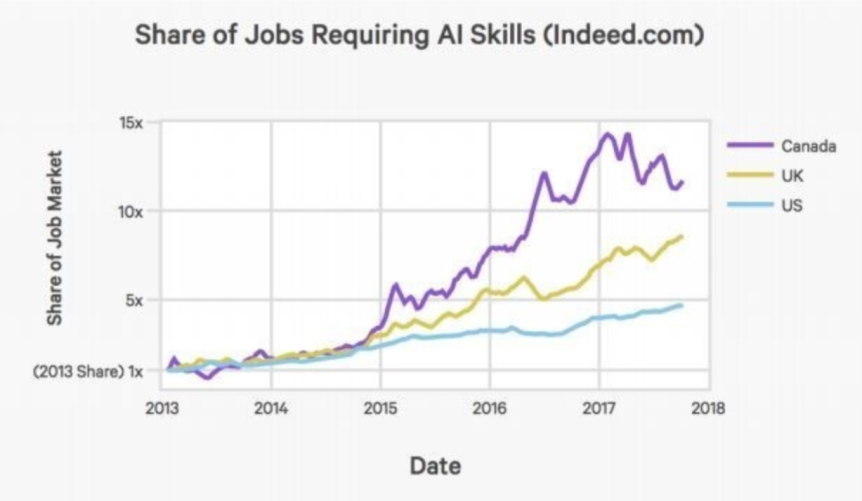
(These charts will change how you see the rise of AI)
As Paul fittingly said:
“We shape our tools and then they shape us.”
To be honest, this is a fairly scary thought to me.
Nonetheless, Paul is absolutely right when he expresses the need for a connected marketer. But how exactly should the connected marketer use the OPPORTUNITY of social media and this constant state of connectedness to make the most out of it for his business? According to Paul, it comes down to four tasks
- Build understanding.
- Enable your audience to do what they want.
- Remove barriers to do business.
- Be of service.
As Paul pointed out, a great example for this is Starbucks. Starbucks faced the problem that they had long queues on peak-times, but people didn’t have the time to queue. In identifying this friction, Starbucks build an understanding of a disadvantageous situation (Step 1). As a solution, they enabled their customers to pre-order and pre-pay their coffee using the Starbucks App (Step 2), while at the same time removing the act of queuing as a barrier to do business (Step 3).In doing so, Starbucks eventually gave the customer the OPPORTUNITY to have the desired coffee without friction and was of service (Step 4). Finally, they promoted this function of their App on social media and benefited from the OPPORTUNITY to reach out to millions of customers.
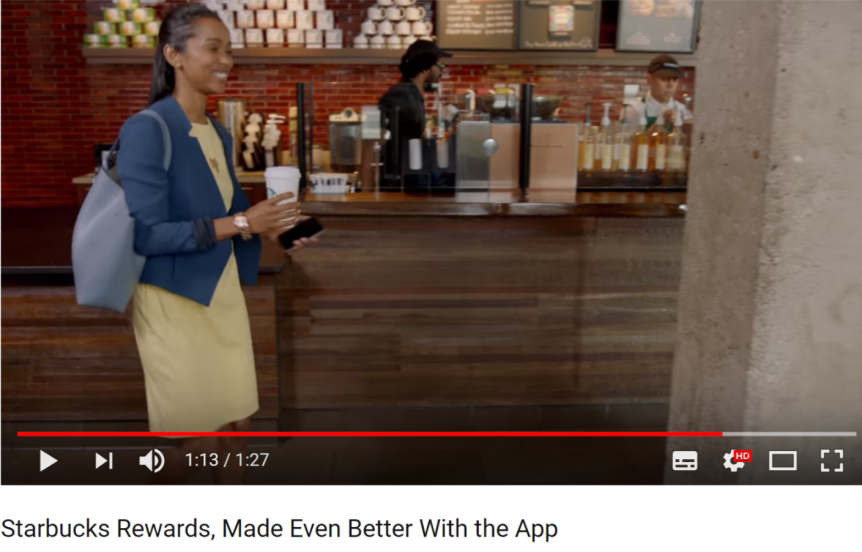 Click here to see their ad video.
Click here to see their ad video.
Personally, I was very impressed with how smart Starbucks has used connected marketing and social media to increase their revenue. Although the long-known marketing core element of value creation (Fahy and Jobber 2015) is still overwhelmingly present in Step 4, the new way of transmitting this value through connected devices is beneficial for the customer and for the business. Therefore, I will definitely keep in mind of what Paul taught us about connected marketing.

If you want to get further insights into the science of connected marketing, download mCordis’ 11 Principles of Connected Marketing here.
It’s worth having a look at!
3. Social media as an OPPORTUNITY for social causes
Social media also possess the OPPORTUNITY to be a place where organisations can publish information on their social causes with an incredible and unscalable wide reach. Social publishing, as we learned in our DICE lecture, is also part of the four social media zones. The other three zones are called social community, social commerce and social entertainment (Social media marketing by Tuten, Tracy L., 1967- author, Solomon, Michael R., author).
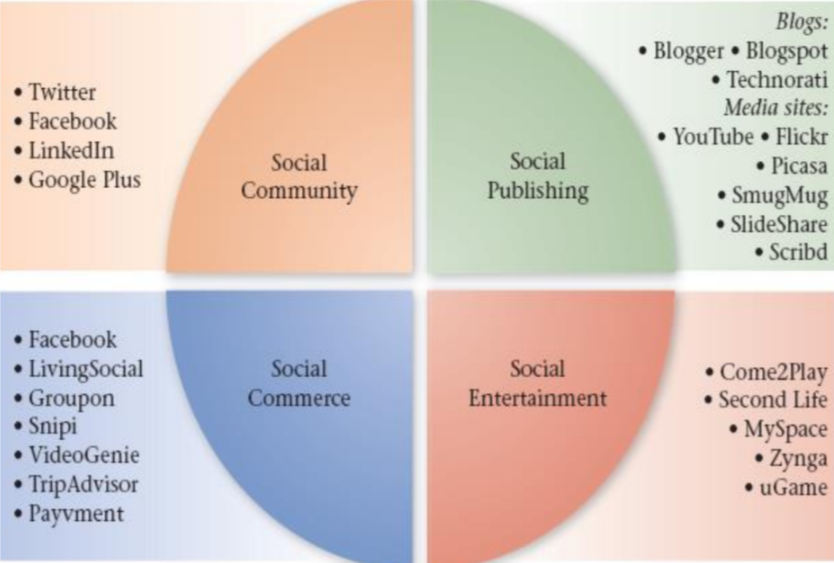
(Sem 2 Intro and SMM.pdf)

Brian Higgins, the CEO of Pieta House, clearly illustrated the zone of social publishing. As stated on their web page, Pieta House is an organisation that provides free therapist counselling to people who suffer from suicidal ideation, engage in self-harm or seek to avail of suicide bereavement counselling. It is their mission to create “a world where suicide, self-harm and stigma have been replaced by hope, self-care and acceptance”.
The following statistic illustrates how widely distributed suicide in Ireland is amongst all age groups (green: female / blue: male):
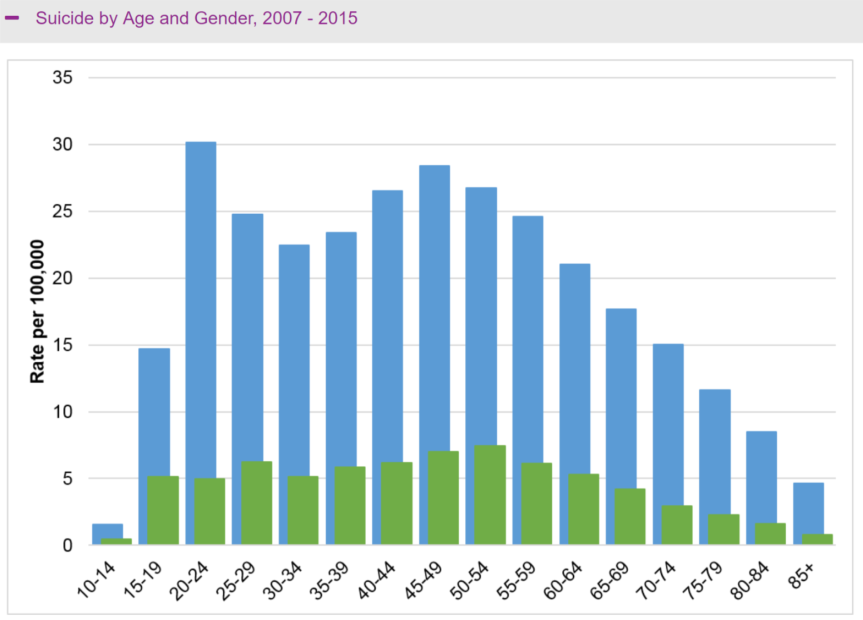
(Suicide – National Suicide Research Foundation)
According to Brian Higgins, each of these suicides impacted 135 people directly negatively. Did you assume that the impact of suicide would be that huge? I didn’t. This is when social media come into play for Pieta House. They are a way for Pieta House to reach out to millions of people and make them aware of this grave issue with their #wakeup campaign. Thus, millions of people now are aware of that issue and try more actively to reduce stigmas, which are for instance associated with racism, homophobia, body-images.
Furthermore, according to Brian, social media are also the most effective OPPORTUNITY for Pieta House to promote their main fundraising event Darkness into Light #DIL2018.

As 90% of Pieta House’s income as a non-for-profit organisation derives from fundraising (About Pieta House), this is crucially important. In using their social networks for fundraising, Pieta House has taken peer-to-peer fundraising to the next level. But what really led to the huge success that Darkness into Light has experienced in the past years are people sharing Pieta House’s call again and again and again, so that it now reaches people that Pieta House wasn’t in contact with in the first place. A real success, for instance, was when William Shatner (the original Captain Kirk) retweeted Pieta House’s call, as he has millions of followers.
To sum it up, Pieta House has perfectioned how they use social media as a tool to keep saving lives. I can only express my deepest admiration for the work they are doing and encourage you all to keep sharing their message #DIL2018.

James Gallagher also introduced his social start-up GiveBack.ie. It aims to end homelessness in Ireland.
 Make sure to download their browser extension and from now on, on some of your online purchases, a percentage will be donated to homeless people!
Make sure to download their browser extension and from now on, on some of your online purchases, a percentage will be donated to homeless people!
4. Social media as an OPPORTUNITY to collect data
We have all seen data about Ireland regarding its population, age distribution, employment rate, etc. But never before have we seen this: A census which aims to explore the emotional state of the Irish nation.
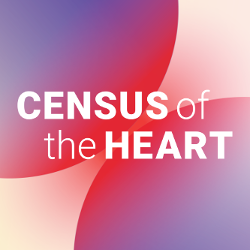 Kathy Scott from The Trailblazery with help from SurveyMonkey realized such a Census of the Heart in 2016, 100 years after the historic Easter rising. It consisted of 39 questions, was available in Irish and English and could be filled out by all inhabitants of the island of Ireland. It is commonly known that a census gains its quality as the number of participants rises. According to Kathy, the best way to gain such numbers was by using social media to raise awareness for the census and to get people to fill it out. And it is only by this OPPORTUNITY offered by the rapid and wide distribution range of social media that Kathy finally received 12.500 responses! As she said herself at the conference, she was completely overwhelmed by those numbers and also the high degree and depth of emotional revelation. To her, the results are like a “library of human emotions at a particular point in time”. If you are curious, why don’t you have a look at the results yourself? Click here.
Kathy Scott from The Trailblazery with help from SurveyMonkey realized such a Census of the Heart in 2016, 100 years after the historic Easter rising. It consisted of 39 questions, was available in Irish and English and could be filled out by all inhabitants of the island of Ireland. It is commonly known that a census gains its quality as the number of participants rises. According to Kathy, the best way to gain such numbers was by using social media to raise awareness for the census and to get people to fill it out. And it is only by this OPPORTUNITY offered by the rapid and wide distribution range of social media that Kathy finally received 12.500 responses! As she said herself at the conference, she was completely overwhelmed by those numbers and also the high degree and depth of emotional revelation. To her, the results are like a “library of human emotions at a particular point in time”. If you are curious, why don’t you have a look at the results yourself? Click here.
Having experienced the immense power that social media had had in raising data in Kathy’s case, Kathy ended her talk with the following quote out of the New Yorker artist Jonathan Harris manifesto “Data will help us”:

Kathy finally put special emphasis on the question: How can we help each other see the world as it could be?
This is a tough question to answer. One possibility that I got to know better during the conference is definitely to contribute spreading great ideas and dreams, also by using social media. And even better, to come up with own ideas and share them with the world!
Please share your thought on that question below in the comments with us!
Concluding …
 Despite my concerns in the first place, Get Social 2018 was another enriching, special and amazing experience! It made me realize for the first time what value social media can provide for humanity and encouraged me to explore the world of social media to a higher extent that I have done so far – to either create a valuable network, obtain useful information or share purposeful events! And I do strongly encourage you to do the same!
Despite my concerns in the first place, Get Social 2018 was another enriching, special and amazing experience! It made me realize for the first time what value social media can provide for humanity and encouraged me to explore the world of social media to a higher extent that I have done so far – to either create a valuable network, obtain useful information or share purposeful events! And I do strongly encourage you to do the same!
However, I also encourage you to have a look at Aideen Burke’s talk at Get Social, so that when benefiting from the OPPORTUNITIES offered by social media, you stay legally safe!
What really interests me now are your thoughts on social media as an OPPORTUNITY!
- Do you use social media? Which?
- Did you make any positive experiences with social media as an OPPORTUNITY yet?
- Do social media contain more OPPORTUNITIES which I haven’t discovered yet?
- Did my blog help you discover more sides of social media?
- Do you feel inspired by the stories told by the speakers?
Whatever it is, as long as it relates to social media or social media marketing, please share it with us below!
Cheers!
Reference List:
- 8 Ways Generation Z Will Differ From Millennials In The Workplace. Available from: https://www.forbes.com/sites/deeppatel/2017/09/21/8-ways-generation-z-will-differ-from-millennials-in-the-workplace/#53e0f5e476e5 [Accessed February 24, 2018].
- About Pieta House. Available from: http://www.pieta.ie/about [Accessed February 25, 2018].
- Bresman, H. and Rao, V.D. 2017. A Survey of 19 Countries Shows How Generations X, Y, and Z Are — and Aren’t — Different. Harvard Business Review. Available from: https://hbr.org/2017/08/a-survey-of-19-countries-shows-how-generations-x-y-and-z-are-and-arent-different [Accessed February 24, 2018].
- Fahy, J. and Jobber, D. 2015. Foundations of marketing. Fifth edition. London: McGraw-Hill Higher Education.
- Get Social 2018 – Free social media mini-conference. Available from: https://www4.dcu.ie/dcu-events/2018/Feb/Get-Social-2018-Free-social-media-mini-conference.shtml [Accessed February 24, 2018].
- Ramasubbu, S. 2015. Influence of Social Media on Teenagers. Huffington Post.
- Sem 2 Intro and SMM.pdf. Available from: https://loop.dcu.ie/pluginfile.php/2077864/mod_resource/content/1/Sem%202%20Intro%20and%20SMM.pdf [Accessed: 25 February, 2018].
- Social media marketing by Tuten, Tracy L., 1967- author, Solomon, Michael R., author. Available from: https://capitadiscovery.co.uk/dcu/items/733403?query=Tuten+AND+Solomon&resultsUri=items%3Fquery%3DTuten%2BAND%2BSolomon [Accessed February 25, 2018].
- Suicide – National Suicide Research Foundation. Available from: http://www.nsrf.ie/statistics/suicide/ [Accessed February 25, 2018].
- These charts will change how you see the rise of AI. World Economic Forum. Available from: https://www.weforum.org/agenda/2017/12/charts-artificial-intelligence-ai-index/ [Accessed February 25, 2018].
- Über LinkedIn. Available from: https://about.linkedin.com/de-de [Accessed February 24, 2018].
- Why College Freshmen Need To Major In LinkedIn. Available from: https://www.forbes.com/sites/williamarruda/2014/08/26/why-college-freshmen-need-to-major-in-linkedin/#5fd21f115d64 [Accessed February 24, 2018].














